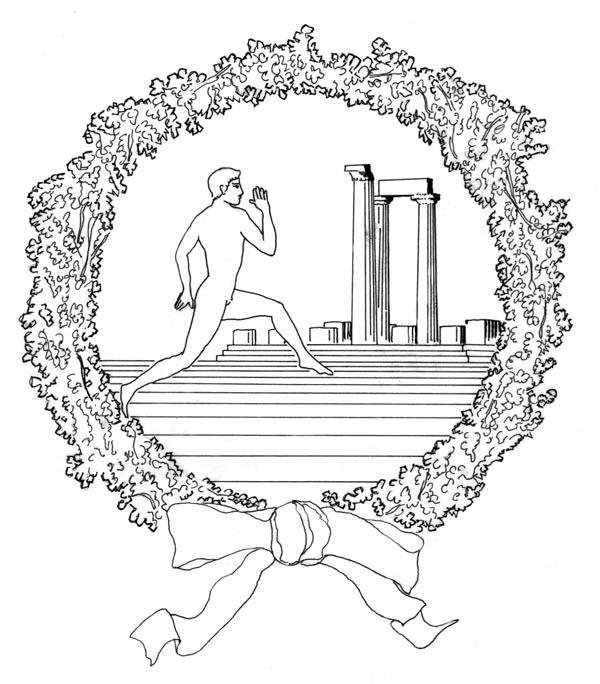
ἅρμα δ᾽ ὀτρύνει Χρομίου Νεμέα θ᾽ ἔργμασιν νικαφόροις ἐγκώμιον ζεῦξαι μέλος
The ancient stadium at Nemea is comprised of a few different elements: the apodyterion (locker room), the vaulted entrance tunnel, and the stadium track itself. The stadium area as we see it today was constructed in the 4th century, around 330 B.C., when the games returned from Argos. It is similar to other stadiums of the Early Hellenistic period such as those at Olympia and Athens. Athletes and poets competed on this track for fame and recognition in the Greek world.
The ancient builders took advantage of the natural terrain where they could, but they also constructed some parts of the stadium by using the latest engineering techniques of the time. The southern, curved end of the track (top of the photograph at left) was carved between two natural ridges that extended northward from the Evangelistria hill while the northern end of the track was set up on an artificial terrace that had been created from the recycled earth dug out from the southern end.
(Text above: “”The chariot of Chromius and Nemea urge me to harness a song of praise for deeds of victory” – Pindar, Nemean 1; trans. Diane Arnson Svarlien. 1990)
APODYTERION
At the far (west) end of the tunnel are the remains of a simple rectangular building with a three-sided interior colonnade. The details of its entrance from the north are not preserved, but thanks to stamps on the roof tiles we know that the architect was named Sosikles and that he was an official from Argos. The building blocks access to the entrance tunnel and was probably reserved for athletes and judges (just as was the case at ancient Olympia). Athletes used this space to prepare themselves for the competition: they removed their clothes, rubbed themselves with olive oil, and made ready to enter the stadium through the vaulted entrance tunnel.

Apodyterion
ENTRANCE TUNNEL
From the apodyterion, athletes stepped into the entrance tunnel, just over 36m long, and made their way toward the stadium. The tunnel’s vault is one of the earliest attested from ancient Greece and shows that, together with tombs in Macedonia, engineers from the time of Alexander the Great knew and used this architectural form. In addition to the well-preserved architecture, there are several dozen ancient graffiti scratched into the surface of the tunnel walls. One, for example, records the name TELESTAS (perhaps the known Olympic victor) and in a different hand the verb NIKO. It seems that the ancient athlete, perhaps while waiting for the herald to announce his hame, etched his name into the side of the tunnel.

Entrance tunnel
THE RUNNING TRACK
The whole track was 600 feet long. In fact, the original meaning of the word stadium (or, stadion in Greek) refers to the unit of measurement equaling 600 feet. The track surface itself was prepared with hard-packed gray-green clay. Today it has been covered over with sand to protect it from the weather and visitors. To prepare the track for the Nemean Games, the track surface was dug up, leveled, and rolled every two years. This practice is attested at other sites, including the stadium at Delphi. This process allowed the track surface to be maintained at the same height from the time of its construction (4th century B.C.) until the second half of the 4th century A.D. There are remains of a water channel, water basin, settling basin, the 300-ft (half-way) marker, the starting line, judge’s stand, and possibly even some of the “front-row seats” for important visitors to the Nemean Games.

Stadium
THE NEMEAN GAMES
Nemea comprised one of four sites in ancient Greece that celebrated athletic and religious festivals on a four-year cycle (so, each year games were held at one of the four sites). The other three sites were Delphi, Isthmia, and (best known today) Olympia. All Greeks gathered for these celebrations – they even suspended wars and hostilities by means of a sacred truce in order to come together for the athletic competitions. For this reason, the above-mentioned sanctuaries, including Nemea, are referred to as “Panhellenic Sanctuaries.” Even if the games took place over the course of only a few days per year, the impulse toward peace was really the first such effort on an organized, regular, and international scale in the history of mankind. The ancient stadium discovered at Nemea can therefore be considered an important monument for the consolidation of local and national identities, but also for the history of institutionalized international collaboration.

The Nemean Games
THE SOCIETY FOR THE REVIVAL OF THE NEMEAN GAMES
In light of the site’s importance and in the true spirit of international cooperation and athleticism, the Society for the Revival of the Nemean Games was formed. Every four years modern athletic games are held at the ancient site of Nemea. No records are kept and no medals are awarded, but participants follow the same rituals and tracks utilized by athletes over 2,000 years ago. The next event is set for this summer – 2020 – and promises to be great fun! To find out more about the Society for the Revival of the Nemean Games, this summer’s games, and about the history of the games in general, visit their website.

